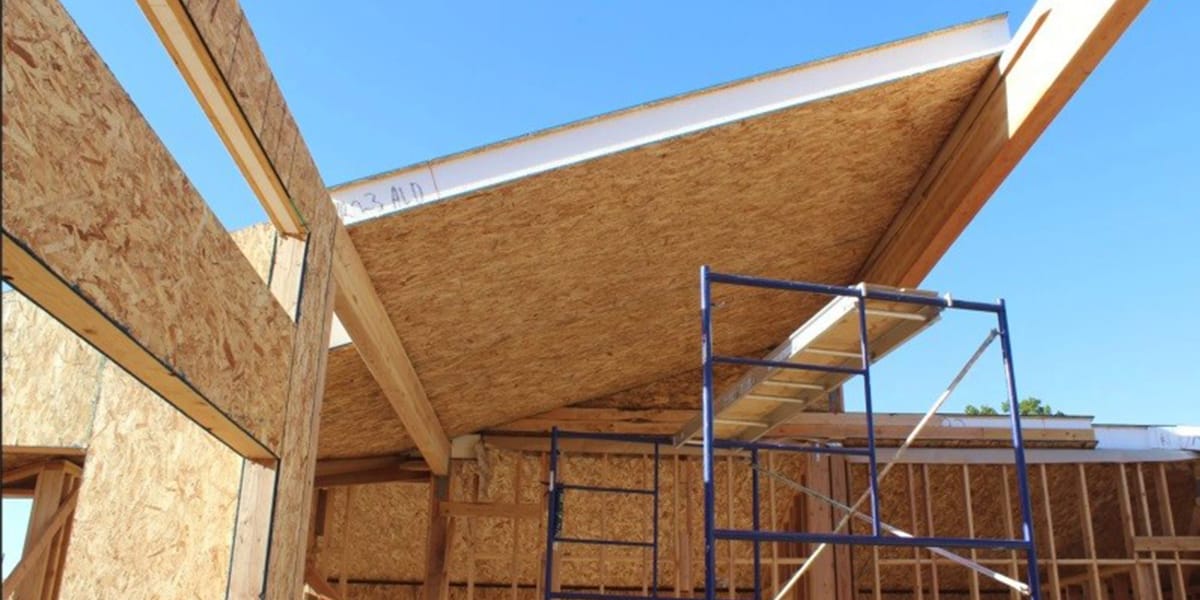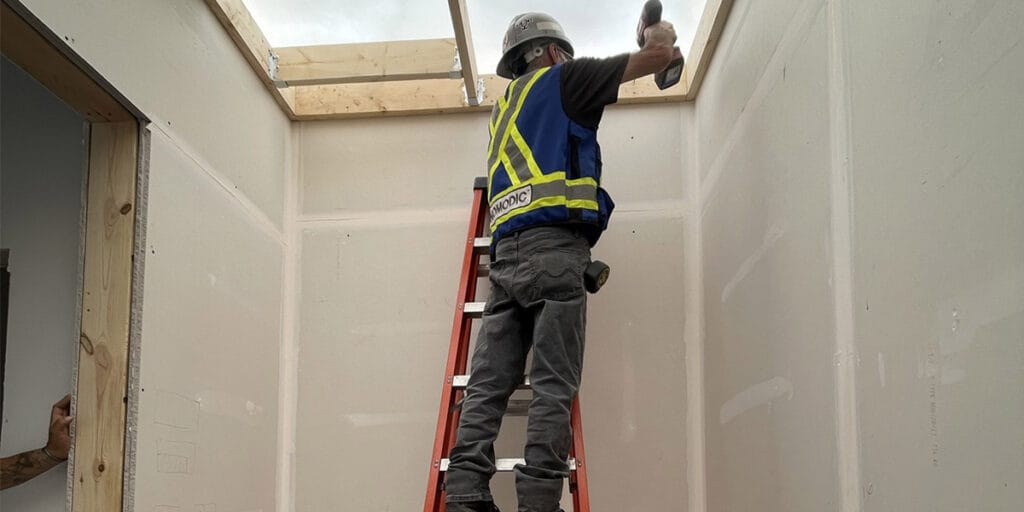
19 May Structural insulated panels disadvantages
Table of Contents
Structural insulated panels are now widely used in building projects. Their insulation core keeps heat in or out very well. This helps keep homes comfy and lowers heating and cooling bills. SIPs also use much less wood than regular building methods. This saves money and natural resources. But there are some problems too. They can cost more at first, have fewer design options, and may have issues with water or bugs. It’s important to know these downsides before choosing SIPs for your project.
Key Takeaways
SIPs can cost more than regular building materials. Check your budget and think about future savings before deciding.
SIPs might have problems with water and bugs, especially in wet places. Use good sealing and ventilation to stop damage and pests.
SIPs work best with simple designs, not fancy ones. Plan your building carefully to avoid extra costs or trouble.
It can be hard and pricey to find workers who know how to install SIPs. Hire trained workers to avoid mistakes or delays.
SIPs are made from materials that can’t be reused, which can harm the environment. Look for brands that use recycled or eco-friendly materials to help the planet.
High Costs of Insulated Panels
Expensive upfront investment
Using insulated panels can cost a lot at first. These panels are pricier than regular building materials. For example, installing insulated metal panels (IMPs) costs $10 to $15 per square foot. A 15,000-square-foot building could cost over $200,000 just for installation. Many builders avoid these panels due to the high starting price. In 2023, over 4,000 projects skipped IMPs because of cost concerns. Also, it can take 7 to 10 years to recover the money spent. This long payback time may not work if you want faster savings.
Price changes and limited supply
The price of insulated panels depends on more than production. It changes with outside factors too. For example, raw materials like EPS and Polyisocyanurate depend on crude oil prices, which often change. Supply chain problems make things worse. Limited raw materials and delivery issues make panels harder to get in some areas. High demand for panels in industries like cold storage also raises prices.
Factor | Description |
|---|---|
Raw Material Price Changes | Costs of materials like EPS and XPS go up and down. |
Growing Demand | More panels are needed for cold storage, increasing demand. |
Supply Chain Problems | Trouble getting materials and delivering panels slows production. |
These issues make it hard to plan costs, which can mess up your budget.
Long-term savings might not cover high costs
Insulated panels save energy, but they cost a lot upfront. Studies show they are 56% more expensive than stick framing at first. Over time, they can save 65% with benefits like lower labor costs and faster building. Even with these savings, the long payback time and high initial cost might make you think twice about using them for your project.
Moisture and Pest Problems
Water damage and mold risks
SIPs work well but can have trouble with water. Many panels use wood, which can rot if wet too long. In humid places, bad sealing lets water in, causing mold. Mold can weaken the building and harm health. To stop this, add waterproof layers or barriers. This is very important in damp areas like basements.
SIPs are airtight, which can cause condensation. Without good airflow, damp air stays inside. This makes it easy for mold to grow. Adding ventilation systems helps keep the air fresh and protects the panels from water damage.
Problems with termites and rodents
SIPs with wood can attract pests like termites and mice. These pests chew the panels, making the building weaker. Some SIPs, like RAYCORE, are made to resist pests. But you still need treatments, like borate foam, to keep pests away.
Extra moisture control needed
To make SIPs last longer, you need moisture control. Poor sealing can let water in, causing mold. Adding vapor barriers, waterproof layers, and drainage systems helps stop water problems. This is very important in rainy or humid areas where water issues happen more often.
Design and Modification Limitations
Limited design options
Insulated panels limit creative building designs. They work best for simple shapes like boxes. Unique designs, like curves or complex layouts, need extra materials. This adds cost and makes building harder. Cutting panels precisely is also tricky. Mistakes can waste materials and raise expenses.
Tip: If saving energy matters more than custom designs, insulated panels could still work for you.
Here’s a summary of design challenges:
Design Limitation | Effect |
|---|---|
Raises costs and wastes materials | |
Best for boxy shapes | Limits creative building designs |
Complex designs not ideal | Lowers building performance |
Hard to change after building
Changing a building later is tough with insulated panels. Their design makes it hard to adjust walls or add features. For example, adding a door or window needs special tools and skilled workers. This can cost a lot of money.
Some common issues include:
Changes need more time and money.
Prefab panels make custom designs harder to add.
Unique features increase costs and difficulty.
If you think you’ll need changes later, decide if insulated panels fit your plans.
Modifications can weaken strength
Changing insulated panels after they’re built can make them weaker. These panels are strong when left as designed. Cutting or drilling can reduce their ability to handle stress. For example, adding openings or changing walls can make them less sturdy in earthquakes or strong winds.
Research shows:
Panels stay strong if left unaltered.
Changes lower efficiency compared to regular methods.
Altering panels may reduce their ability to handle stress.
To keep your building strong, avoid big changes or ask an expert before modifying anything.
Specialized Labor and Installation Challenges

Need for skilled workers
Putting in SIPs needs workers with special skills. Regular builders usually can’t do this job well. The panels must fit perfectly to save energy. This takes careful work and training. From 2021 to 2023, builder wages went up by 20%. This shows how hard it is to find skilled workers. If you want to use SIPs, plan for higher worker costs.
Hard to find trained crews
It’s not easy to find crews who know SIPs. Many builders don’t have the right training for these panels. The job needs special skills, like sealing edges to stop air leaks. But there’s already a shortage of workers in construction. This makes finding trained crews even harder. Without them, your project could face delays or mistakes. These problems might hurt your building’s quality.
Note: Always check your crew’s skills to avoid costly errors.
Higher labor costs and possible delays
Skilled workers are in high demand but short supply. This raises labor costs for SIP projects. Hiring trained crews can make your project more expensive. Also, fewer workers mean longer wait times. If you’re on a tight schedule, delays can mess up your plans. For example, waiting for a crew could take weeks or months. To avoid this, book skilled workers early and plan ahead.
Environmental and Durability Concerns
Use of non-renewable materials in production
SIPs are made using materials that can’t be replaced. The foam cores, like EPS or polyisocyanurate, come from oil-based products. These materials harm the environment because they aren’t renewable. The outer layers, usually OSB, need glues and resins made from fossil fuels. This heavy use of non-renewable resources raises concerns about sustainability. If you care about eco-friendly building, SIPs might not be the best choice.
Tip: Choose brands using recycled or alternative materials to help the planet.
Recycling and disposal challenges
Throwing away SIPs creates big problems. Foam cores are hard to recycle because of their chemicals. Many panels end up in landfills, adding to waste. In 2018, the U.S. made 600 million tons of construction waste, more than double regular trash. Some companies, like Kingspan, try to reuse foam scraps. At their DeLand plant, foam becomes filler for countertops and siding. These efforts help but are still small-scale.
Main recycling problems:
Foam cores are tough to recycle due to chemicals.
Construction waste fills up landfills quickly.
Reuse programs exist but aren’t common everywhere.
Durability issues with materials like OSB
OSB, used in SIPs, can have durability problems. It swells and weakens when it gets wet. This can make buildings less sturdy. In humid areas, bad sealing lets water in, damaging the OSB over time. Even though OSB is treated to resist water, it’s not perfect. If you live in a rainy or coastal area, SIPs may need extra care to last longer.
Note: Check panels often and use protective coatings to make them last longer in wet places.
Structural insulated panels save energy and are quick to install. But, they also have some downsides to consider. They can be expensive, may have water problems, and limit design options. If saving energy and building quickly are your priorities, they might still work well. Always think about your needs and ask experts before choosing.
FAQ
What are structural insulated panels (SIPs) made of?
SIPs have a foam center, like EPS or polyisocyanurate. This foam is placed between two hard layers, such as OSB or metal. Together, these parts make strong and insulated panels.
Can SIPs be used in all climates?
SIPs work in most places but struggle in wet areas. Good sealing and systems to manage moisture are needed to stop mold and water damage.
Are SIPs environmentally friendly?
SIPs use materials that can’t be replaced, like foam and glue. These can hurt the planet. Recycling them is hard, but some companies use recycled parts to help the environment.
How long do SIPs last?
SIPs can last many years with proper care. Checking them often, sealing well, and controlling moisture can make them last longer, especially in wet places.
Do SIPs require special maintenance?
Yes, SIPs need regular care to check for water, pests, and damage. Adding coatings and keeping air flowing helps them stay strong over time.
